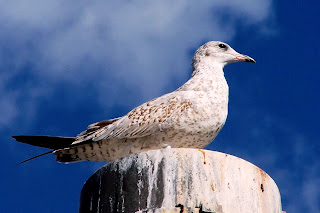The European or Common Starling is very common species here in New Jersey and along with two other common species, the Pigeon (Rock Dove) and Canada Goose, one of our most detested. Introduced into New York City's Central Park 120 years ago, it is an agressive species that has spread across the United States and nearly wiped out our native Eastern Bluebird. Most birders rarely give it a second look once they have IDed it. However, an unexpected result of my recent class on Gull Identification is that I've also started to take a closer look at some of these overlooked species. As it turns out, I find European Starlings in their breeding plumage to be an interesting species. Next time you see a Starling, take a second look and see if you agree.
Friday, March 26, 2010
Friday, March 12, 2010
Ring-billed Gulls
I built on the lessons that I had learned on plumage & molts from last weekend's Class on Gull Identification by spending this week reviewing all of my gull photographs, trying to ID each gull to year class. The Ring-bill Gull takes 3 years to become an adult. Although, it is a common gull here in New Jersey (especially in Winter), I found that I had been over-looking 2 year old birds (2nd Cycle), thinking that they were just dull looking adults. Juvenile and 1st cycle birds clearly look very different from the adults; however, differences between 2nd cycle birds and adult are much more subtile (bill color, the amout of white on wing tips). Gull Identification is definately advanced birding!
Juvenile
Juvenile
1st Cycle
2nd Cycle
Adult - Basic Plumage
Adult - Alternate Plumage
Sunday, March 7, 2010
American Herring Gull
I went down to Cape May on Saturday for a full day of class on Gull Identification. We spent most of the day focusing our attention on the American Herring Gull. We must have looked at close to 1000 gulls in the field and then viewed more on slides in the class room. Herring Gull Identification? How hard can it be to identify the most common gull on the Jersey Shore? The answer is it depends! Adult Herring Gulls look nearly identical in either their Basic (non-breeding or fall) Plumage or in their Alternate (Breeding or Spring) Plumage and just about anyone can recognize an adult. The problem is that it takes a Herring Gull four years to become an adult and each immature year class (called cycles) also has a different appearance in their Basic and Alternate plumages. A first cycle Herring Gull looks very different from an adult. Suddenly we now are up to eight different plumages for the species (and we didn't even address subspecies variation). Then to make matters even worse, they don't molt and grow in their new feathers over night. So a molting a gull will have an intermediate appearance that can be anywhere in between its Basic and Alternate plumages! Talk about a challenge! Now for the good news, most species of gull go through a similar sequence of molts from juvenile to adult. So knowing what a Herring Gull looks like at all ages and molts becomes essential when you are scanning a large flock of gulls trying to locate one rare gull. Turns out Gull Identification is very advance birding.
Immature - First Cycle
Adult - Basic Plumage

Immature - First Cycle

Adult - Basic Plumage

Adult - Alternate Plumage

Subscribe to:
Comments (Atom)







